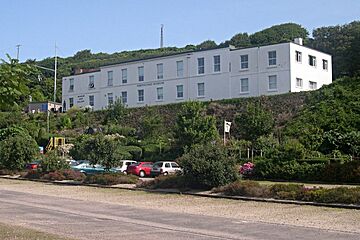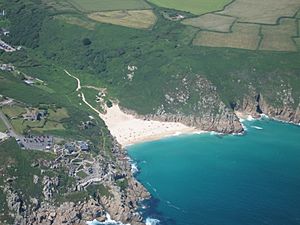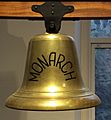PK Porthcurno facts for kids
| PK Porthcurno: Museum of Global Communications | |

The museum building in front of the tunnels
|
|
| Lua error in Module:Location_map at line 420: attempt to index field 'wikibase' (a nil value). | |
| Established | May 1998 |
|---|---|
| Location | Porthcurno, Cornwall, United Kingdom |
| Type | Telecommunication museum |
| Founder | Former employees of Cable & Wireless plc |
PK Porthcurno is a museum located in the small coastal village of Porthcurno in Cornwall, UK. This special place was where many underwater communication cables, including those crossing the Atlantic Ocean, came ashore. These cables were like the internet of the past, sending messages across the world.
The museum opened in May 1998. It is located inside the old buildings and tunnels that were once part of the telegraph station.
Contents
The Story of Porthcurno's Cables
In June 1870, a very important event happened in Porthcurno. A company led by John Pender finished laying the first underwater cable connecting Great Britain to India. This cable allowed messages to travel all the way from Bombay (now Mumbai) to London.
The very first message was sent on June 23, 1870. It arrived at John Pender's house in London, where he was hosting a party. The message was received using a special machine called a siphon recorder, invented by Sir William Thomson. The next day, the cable was open for everyone to use.
Porthcurno soon became the world's largest underwater telegraph station. It started with a small team of 16 young men. More cables were added over time, connecting Porthcurno to places like Newfoundland, France, Spain, and Gibraltar. This made Porthcurno a vital link for communication across the British Empire.
During World War II, the telegraph station was at risk of attack. To protect the important equipment, miners dug tunnels deep into the granite hillside in 1941. The telegraph facility at Porthcurno continued to operate for 100 years, finally closing in 1970. Today, most international information travels through modern fibre optic cables, which are much lighter and faster.
How the Museum Grew
The museum was started by people who used to work for a company called Cable and Wireless. It is now located in the tunnels that were dug during the war, near Porthcurno beach. The museum received a grant from the Heritage Lottery Fund to help set up its displays.
The museum shows the history of how underwater cables were laid by ships. It also has many different types of old cables and working telegraph equipment. Porthcurno was also a training college for people in the communications industry until 1993.
In 2010, a new exhibition called "The Nerve Centre of Empire" opened. It was designed to be an educational experience for children and young people. The museum has about 16 staff members and many volunteers. They welcome visitors and help with research questions from people studying history or their families.
The museum has also improved its buildings. It added more exhibition space, a cafe, and made it easier for everyone to visit. This big project was supported by many different groups. A new learning center, called the Clore Learning Space, was also built. The museum closed for a short time in 2013 for these changes and reopened in summer 2014. In 2020, the museum was renamed PK Porthcurno: Museum of Global Communications.
In March 2022, the museum was featured on a BBC Radio 4 show called The Museums That Make Us, presented by Neil MacGregor.
What You Can See at the Museum
The museum has a very important collection of items. It includes a large collection of photographs and old records from the Cable & Wireless company. You can also see models of cable ships, paintings, old company magazines, and samples of different types of underwater cables. This includes the first transatlantic telephone cable, called TAT-1. There is also a variety of old telegraph equipment on display.
People Who Work and Help at the Museum
The museum has about 16 professional staff members, most of whom work full-time. It also has a large group of volunteers. Many of the technical volunteers used to train or teach at the Porthcurno technical training college before it closed in 1993.
Awards the Museum Has Won
The museum has received several awards since it opened. These include:
- Cultural Enterprises Awards 2020: Green Award
- Cornwall Tourism Awards 2018/19: Gold – Small Attraction of the Year
- South West England Tourism Excellence Awards 2018–2019: Highly Commended – Small Attraction of the Year
- Holyer an Gof Awards 2017: Winner in the Booklets Class, Changing Places: Porthcurno and the roots of modern communication
- South West England Awards 2014–2015: Silver – Small Visitor Attraction of the Year
- South West Tourism Excellence Awards 2012/13: Bronze – Small Visitor Attraction of the Year
- Cornwall Tourism Awards 2012: Gold – Small Visitor Attraction of the Year
Gallery








